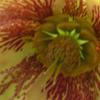
Anyway, back to the book. It follows more or less the same format as the other books in this series from Timberpress and positively groans with sumptuous photographs, the majority taken by the author, leaving you in no doubt that your world would be a much better place with the addition of some tulips even if they are only in a pot. Richard Wilford is well placed to write about tulips. He has worked at the Royal Botanic Gardens, Kew for 26 years with a particular interest in bulbs and is a member of the RHS’s Bulb Committee. This is not his first outing as a writer since he wrote Tulips, Species and Hybrids for the Gardener, also for Timberpress, which was published in 2006 as well as Alpines: From Mountain to Garden (2010) and Growing Garden Bulbs (2013) both published by Kew.
Richard starts out by giving a little bit of a history lesson and then explaining that there are 3 main ways you can grow tulips in your garden: mass bedding, in a mixed border or in pots. For each approach he gives examples of which tulips best and illustrates his advice and recommendations appropriately so for bedding you have the obvious choice of the Keukenhof Gardens in Holland and for mixed borders and to a lesser degree containers he turns to Great Dixter for inspiration. There is a discussion on what plants would work well with the tulips in pots and the mixed border but to me of more interest were the paragraphs on planting tulips in a gravel garden, rock garden and unexpectedly a woodland garden. I was very surprised that there were some tulips that would take some shade so welcomed a list of suitable varieties and the advice given about using tulips in this way.
The book then goes on to explain tulips as a genus and describe each of the 15 classification groups of tulips giving examples and some illustrations. The language is straight forward and accessible so you don’t get in a muddle with petals, tepals, sepals and other such botanical lingo. This section also identifies which groups generally flower when and interestingly which groups of tulips are good for naturalising. I was interested to learn that tulips, unlike most other bulbs, do not bulk up their bulbs each year but produce a new bulb each year. This means you need to ensure that the plant isn’t allowed to dry out before the foliage has died naturally or the plant will not have time to produce and bulk up the new bulb. Understanding this helps you to understand why many tulips don’t do well if left in the ground year on year or even lifted and stored, unless you can given the bulbs the right conditions. It left me thinking that in future I will concentrate on those groups of tulips which might naturalise.
Then you have 100 different tulips set out for you, arranged in color groupings, with each variety given a page and well illustrated. The entries give a little history of the variety and detailed description as well as telling you the classification group, height, bloom time, preferred growing conditions and suggestions for ways of using that variety in your borders, which other tulips or plants would work well with it and also some alternative but similar looking tulips. I particularly liked the inclusion of alternatives as it does really depend on which bulb merchant you go to as to which variety might be available.
The final section covers planting tulips, including advice on growing in containers and also growing species tulips, what conditions they need, propagation and pests. I was surprised that there was no mention of the predilection that badgers and many other rodents have for tulip bulbs, the section focussed on the tulip fire virus and slugs. I suspect Richard may not have experienced the disastrous combination of tulips and badgers, indeed I rarely meet someone who has, but I would have expected the book to mention the problems of mice and squirrels. As with all the books in this series there is a short section on where to buy and see tulips at the back including sources outside of the UK.
I enjoyed reading this book more than I was expecting to, I learnt some interesting bits of information and I found myself rethinking the possibility of growing tulips in my garden albeit in containers. I know from social media that tulips seem to have become increasingly popular in recent years so if you are into your tulips or thinking about giving them a go I would recommend this book as it helps to demystify those classifications which you see in bulb catalogues and on websites and provides planting of inspiration on how to use these jewel like flowers in your garden.

